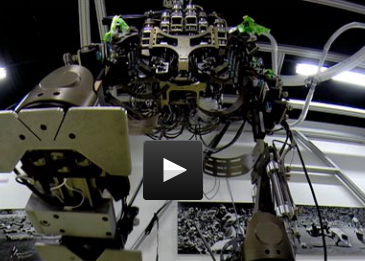Wired.comMind-Controlled Machines Give Paralyzed Patients New Hope |
|
TED Global 2014Miguel Nicolelis: Brain-to-brain communication has arrived. How we did it. |
|
Exclusive look at World Cup opening ceremonyWith the start of the 2014 World Cup in Brazil just a few hours away, organizers say the show will be spectacular, including a remarkable moment when a paralyzed man walks. |
|
World Cup exoskeleton will allow paraplegic to walk again |
|
Robotic exoskeleton gears up for World Cup debut |
Miguel Nicolelis at TEDMED 2012The founder of Duke’s Center for Neuroengineering presents his astonishing work on mind-controlled robotic avatars, which have already been successful in primate research. |
Duke study: Monkeys “Move and Feel” Virtual Objects Using Only Their BrainsIn a first-ever demonstration of a two-way interaction between a primate brain and a virtual body, two monkeys trained at the Duke University Center for Neuroengineering learned to employ brain activity alone to move an avatar hand and identify the texture of virtual objects. |
Monkey’s thoughts make robot walk from across the globeIn a first-of-its-kind experiment, the brain activity of a monkey has been used to control the real-time walking patterns of a robot half way around the world, according to researchers at Duke University. |
Spinal Cord Stimulator Sparks Hope for Parkinson’s DiseaseThe future treatment of Parkinson’s disease may target the spinal cord instead of the brain to help alleviate the slow, rigid movements and tremors that are the hallmarks of the disease. Researchers at Duke University Medical Center have developed and tested a first-of-its-kind device that rapidly restored motor function in mice with the symptoms of Parkinsons disease. |
Dorsal column stimulation effects on mouse model of Parkinson’s disease |
Office Hours with Miguel Nicolelis on Brain-Machine InterfacesMiguel Nicolelis is the Anne W. Deane Professor of Neuroscience and co-director of Duke University’s Center for Neuroengineering. He is a native of Sao Paulo, Brazil, where he received his M.D. and Ph.D. in neurophysiology from the University of Sao Paulo. He answered questions about his research on brain-machine interfaces during a live “Office Hours” webcast interview March 18, 2011. |
Miguel Nicolelis – Breaking the Wall of Neurological Disorder @Falling Walls 2009What can a monkey’s thought tell us about Parkinson’s disease? A lot, actually. The neurobiologist Miguel Nicolelis has found a way to implant electrode arrays into a monkey’s brain to detect ist motor intent — and thus to control reaching and grasping movements performed by a robotic arm. |
Mind Control Monkey Moves Robot in JapanIn a first-of-its-kind experiment, the brain activity of a monkey has been used to control the real-time walking patterns of a robot halfway around the world, according to researchers at Duke University Medical Center. The Duke team is working with the Computational Brain Project of the Japan Science and Technology Agency (JST) on technology they hope will one day help those with paralysis regain the ability to walk. |







 Listen to the interview
Listen to the interview






